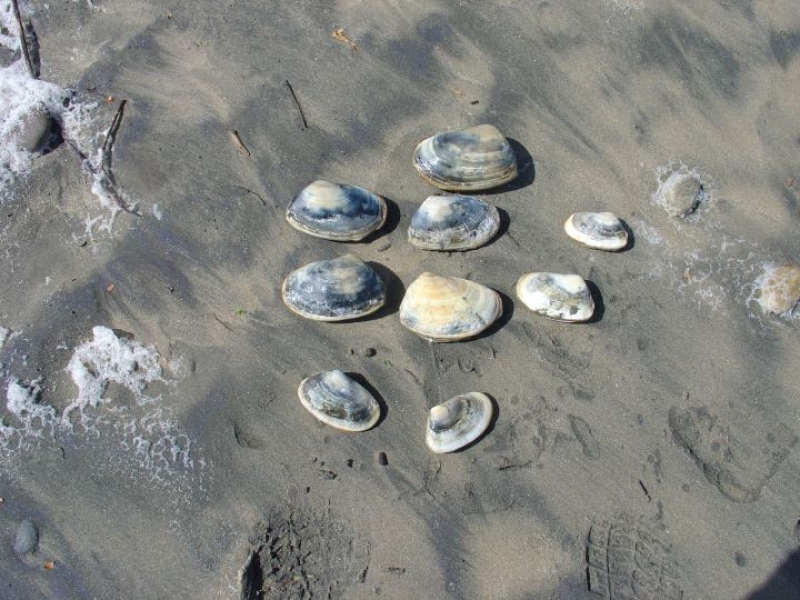Think you’ve got your favourite surf beach to yourself? Think again! There’s life hidden beneath those waves.
“It may look barren, but the high-energy surf zone of exposed beaches is a very productive place, second only to coastal upwellings,” says Keith Michael, a fisheries scientist at the National Institute of Water and Atmospheric Research (NIWA). “It’s rich in phytoplankton [microscopic plants], such as diatoms, that provide a constant ‘soup’ for animals tough enough to survive the waves.”
Among the few species that thrive on surf beaches are the surf clams. These bivalve shellfish live buried in the sand like their smaller relatives, the pipis and cockles. There are seven species of subtidal surf clam found in New Zealand, living at different depths. These range from the deepwater tuatua (Paphies donacina), which lives around the low tide region, to the dosinias and frilled venus shell (Bassina yatei), found at depths of up to 10 metres or more. Although all edible, these species haven’t traditionally been harvested because they’re difficult to get at, living in the breaker zone. “They’re mostly known from shells washed up on the beach after big storms,” says Keith.
Two more familiar species, the toheroa (Paphies ventricosa) and northern tuatua (Paphies subtriangulata), live higher up the beach between the tides. Toheroa are usually found near streams and estuaries where there’s some water flowing through the sand, often below sand dunes. Being easily accessible at low tide, toheroa and northern tuatua have been the basis of important hand-gathering fisheries. Though once abundant on exposed beaches on the North Island’s west coast and in Southland, toheroa are now protected because of declining numbers. Reasons for the decline aren’t entirely clear, although it’s likely to be a combination of overharvesting for canneries in the 1950s and 1960s, followed by habitat loss and crushing by vehicles driving on beaches.
Each species of surf clam is adapted to slightly different habitats, dictated by the degree of turbulence in their environment, water depth, and the coarseness of sand they live in. In the subtidal surf zone, a combination of wave action and coarse sand means that it’s difficult to keep a grip. “The clams living in this zone are adapted to a turbulent environment where the sand is always moving,” says Keith. “Wave action pumps water into the sand, especially in storms, so surf clams keep digging until they reach firm enough sand to anchor,” says Keith. “As you go further out, the finer sand provides a more stable environment.”
The species in the really high-energy zone, where the wave action is strongest, tend to have narrow wedge-shaped shells to enable them to burrow quickly and avoid being dislodged. These include toheroa, northern tuatua, and the ringed dosinia (the penny shell). Lower down on the shore, you find species with more bulbous shells, such as the triangle and trough shells.
Surf clams use their muscular ‘foot’ to burrow and anchor themselves, extending their siphon to the surface to feed on phytoplankton. The siphon is comprised of two retractable fleshy tubes, one for drawing in food and water and the other for expelling wastes. The bigger the clam and the longer their siphon, the deeper they can burrow. “Big toheroa, whose shells can measure up to 200 mm long, burrow the deepest, up to 10 cm or more,” says Keith.
Humans are not the only predators to dig surf clams out of their sand havens. “In late summer and early autumn, when the water is relatively calm and warm, a lot of fish come into the shallows to dig them out – including small sharks, rays, snapper, and trevally, as well as paddle crabs. If a fish can’t get the whole clam, they’ll nip off its siphons,” says Keith. Regrettably, this piscine appetiser is fatal for the clam.
Scientist bio:
Keith Michael is a NIWA fisheries scientist whose research interests include shellfish biology and fisheries (oysters, scallops, and surf clams), and the development of new shellfisheries. He also undertakes research on the linkages between fisheries, fishing, marine ecosystems and the physical environment, and fisheries production.
|
Toheroa Fact File |
|
|
Common names: |
Toheroa |
|
Māori name: |
Toheroa |
|
Scientific name: |
Paphies ventricosa |
|
Type: |
Bivalve shellfish |
|
Family: |
Mesodesmatidae |
|
Size: |
Up to 200 mm in shell length |
|
Lifespan: |
About 12 years (large toheroa) |
|
Diet: |
Diatoms and other phytoplankton |
|
Reproduction: |
Broadcast spawners – adults eject eggs and sperm into the sea in late November and December (when food is abundant). Fertilised eggs develop into tiny larvae that drift in currents for 3–4 weeks before settling. |
|
Things you need to know: |
Toheroa harvesting has been banned since 1993 to protect the species, except for occasional one-day open seasons at Oreti Beach (Southland), declared by the Ministry of Fisheries. |
|
Something strange: |
Canned toheroa soup became such a hit in the 20th Century that demand outstripped supply and the last canning factory closed in 1969. This was despite the soup being khaki-green – a product of the plankton in the toheroa’s gut [Source: Te Ara] |

